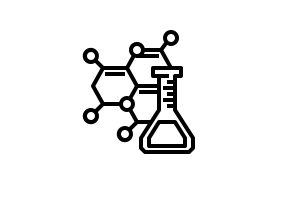Photocatalytic CO2 conversion to HCOOH
 topic
topic
CO2 conversion to formic acid[Pro21]
Formic acid (FA) is a simple chemical with many uses. Its applications include use as a preservative, in the leather and dyeing industry and chemical providing a C1 building block. It is also an important H2 carrier, because of its qualities as non-toxic, easily storable liquid. This also makes it directly usable in fuel cells.[Fas16] The global production is currently estimated at 870.000 metric tons in 2021 with a CAGR (Compound Annual Growth Report) of 3.87% in volume terms during the period 2022-2027.[https://www.mordorintelligence.com/industry-reports/formic-acid-market]
Industrial production of formic acid is done mainly by carbonylation of methanol and subsequent hydrolysation of methyl formate to formic acid.[FA00]
A direct approach of synthesis by hydrogenation of CO2 and using renewable energy, such as sunlight in photocatalysis, in a homogeneous environment, is the focus of this page.
Reaction
CO2 + H2 -> HCOOH
explanation
Sacrificial electron donors
| BIH | BI(OH)H | BNAH | TEA | TEOA |
|---|---|---|---|---|
Ruthenium Catalysts
100549
[Show R-Groups]
100481
[Show R-Groups]
Ru(bpy)2CO3
100483

100552
[Show R-Groups]
complexes ordered by metal
Photosensitizers
photosensitizer compounds
Experiments
| Entry | CAT | conc | PS | conc | e-D | conc | Solvent | λex [nm] | irr time [h] | Sel [%] | TON | QY [%] | reference | link to experiment |
|---|---|---|---|---|---|---|---|---|---|---|---|---|---|---|
| 1 | Ru(bpy)3Cl2 | - | TEOA | DMF | 400 | 1 | 69 | 4 | [Pro85] | |||||
| 2 | 100549 | Ru(bpy)3Cl2 | TEOA | DMF | 400 | 2 | - | 326 | [Pro90] | |||||
| 3 | 100550 | Ru(bpy)3Cl2 | TEOA | DMF | 400 | 2 | - | 255 | [Pro90] | |||||
| 4 | Ru(bpy)2CO3 | Molecule with chemformId 100487 does not exist. | TEOA | NMP | 400 | 5 | 78 | 21 | [PRo15] | |||||
| 5 | Molecule with key C1C2N([*])P([Ru](C#O)(C#O)(Cl)3P(N([*])C(N=23)=CC=1)(C1C=CC=CC=1)C1C=CC=CC=1)(C1C=CC=CC=1)C1C=CC=CC=1r1 does not exist. | Ru(bpy)3Cl2 | TEOA | DMF | 405 | 24 | 99 | 380 | [VLP19] | |||||
| 6 | 100552 | 100533 | BI(OH)H/TEOA | DMA | 500 | 24 | 83 | 3269 | [PCR20] |
table with several experiments
Cobalt Catalysts
100553
[Show R-Groups]
Co(MePP)
tBuxant-(Co(qpy))2
Organic and semiconductor photosensitizer
3,7-Di((1,1'-biphenyl)-4-yl)-10-(naphthalen-1-yl)-10H-phenoxazine
100494

Experiments
| Entry | CAT | conc | PS | conc | e-D | conc | Solvent | λex [nm] | irr time [h] | Sel [%] | TON | reference | link to experiment |
|---|---|---|---|---|---|---|---|---|---|---|---|---|---|
| 1 | 100553 | - | TEA | MeCn | 320 | >80 | 245 | [CPC98] | |||||
| 2 | 100553 | - | TEA | MeCn | 320 | - | 120 | [CPC98] | |||||
| 3 | 100553 | - | TEA | MeCn | 320 | - | 120 | [CPC98] | |||||
| 4 | Co(MePP) | - | TEA | MeCn | 320 | - | 120 | [CPC98] | |||||
| 5 | Co(MePP) | - | TEA | MeCn | 320 | - | 120 | [CPC98] | |||||
| 6 | Co(MePP) | - | TEA | MeCn | 320 | - | 120 | [CPC98] | |||||
| 7 | tBuxant-(Co(qpy))2 | Molecule with key DOIVPHUVGVJOMX-UHFFFAOYSA-N does not exist. | TEA | MeCn | 460 | 92 | 110 | [Sco19] | |||||
| 8 | tBuxant-(Co(qpy))2 | Molecule with key DOIVPHUVGVJOMX-UHFFFAOYSA-N does not exist. | BIH/TEA | MeCn | 460 | 97 | 386 | [Sco19] | |||||
| 9 | tBuxant-(Co(qpy))2 | Molecule with key DOIVPHUVGVJOMX-UHFFFAOYSA-N does not exist. | BIH/TEOA | MeCn | 460 | 76 | 821 | [Sco19] | |||||
| 10 | tBuxant-(Co(qpy))2 | 3,7-Di((1,1'-biphenyl)-4-yl)-10-(naphthalen-1-yl)-10H-phenoxazine | BIH/TEOA | MeCn | 460 | 58 | 565 | [Sco19] | |||||
| 11 | tBuxant-(Co(qpy))2 | 100494 | BIH/TEOA | MeCn | 460 | 91 | 493 | [Sco19] |
Literature
Publication: Photochemical Reduction of Carbon Dioxide to Formic Acid using Ruthenium(II)-Based Catalysts and Visible Light
Publication: Visible-Light Photocatalytic Reduction of CO2 to Formic Acid with a Ru Catalyst Supported by N,N’- Bis(diphenylphosphino)-2,6-diaminopyridine Ligands
Publication: Photocatalytic CO2 Reduction under Visible-Light Irradiation by Ruthenium CNC Pincer Complexes

